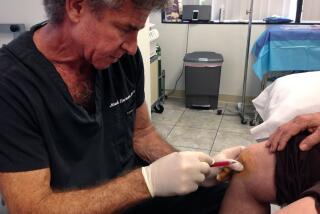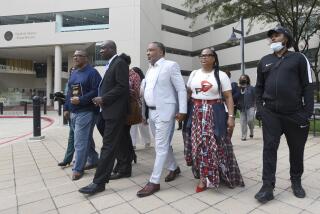Stem Cell Distribution Deal Told
WASHINGTON — Federal health officials on Wednesday unveiled a deal to speed valuable stem cells into the hands of government and academic scientists for basic research, the result of negotiations with the world’s most prominent creator of embryonic stem cells.
But some lawmakers and scientists said the agreement has significant shortcomings, including a ban on using the cells to treat patients. They said it underscores the complex patent and ownership issues that must be navigated as stem cells are studied for their potential to cure disease.
News of the deal came as Health and Human Services Secretary Tommy G. Thompson acknowledged that fewer than half of the 64 stem cell colonies approved for federally funded research are “fully established,” a state of maturity that most researchers require for their experiments. The revelation fueled complaints from research advocates that President Bush’s stem cell policy is too restrictive, but Thompson said the number of mature lines is adequate.
The agreement to supply stem cells was struck with an affiliate of the University of Wisconsin, one of 10 laboratories with stem cells that can be used in federally funded research under rules announced last month by President Bush.
Yet the deal could set the terms for how all 10 owners distribute their cells, because the Wisconsin affiliate holds a patent that it says gives it rights to all human embryonic stem cells used in the United States.
The affiliate, the Wisconsin Alumni Research Foundation, has said it wants to offer the cells to government and academic researchers on liberal terms. On Wednesday, it said it would use its patent to ensure that other creators of stem cells do not demand high fees, excessive rights to new discoveries or other onerous terms in distributing their cells to researchers.
The focus on the 64 cell lines and their owners comes because Bush, in a nationally televised address Aug. 9, announced that the federal government would fund research using only those cells. Bush said that this research is acceptable because the cells already had been extracted from human embryos, a process that kills the embryo. But Bush said the government would not support experiments that caused additional embryos to be destroyed for their stem cells. The president said “more than 60 genetically diverse stem cell lines already exist” that would be eligible for federal funding under his plan. Thompson later called the lines “robust” and “viable for research.”
Some lawmakers and scientists have been arguing that the 64 lines are insufficient. They say many of them will prove unhelpful to researchers and that ownership and patent restrictions will prevent others from reaching scientists.
But, addressing a Senate panel Wednesday, Thompson acknowledged that only 24 or 25 of the cell lines are mature. He called those lines “adequate” for research needs, “but I think we’ll have many more.” The remaining 39 or 40 lines are in an earlier state of development, he said.
Cells Mixed With Mouse ‘Feeder’ Cells
Thompson said that federal officials had always been clear that some cell lines were in an early state of development, and he said researchers were free to devise research proposals on all 64 lines, no matter their state of development.
He also told the Senate Health, Education, Labor and Pensions Committee that all 64 lines had been mixed with mouse “feeder” cells, which provide nutrition to the human stem cells. This could make the cells ineligible for use in medical treatments because of federal rules designed to prevent the spread of animal diseases to humans.
Thompson said this was not an insurmountable hurdle and that federal officials might approve medical treatments involving animal materials that meet certain health standards.
But Sen. Tom Harkin (D-Iowa) said mouse “contamination” is “a very dark cloud.” Sen. Edward M. Kennedy (D-Mass.), the committee chairman, said he also considers the mouse cells to be a problem, noting that “ ‘mad cow’ disease” had come to humans through inadvertent transfer from animals.
Embryonic stem cells are prized by researchers because they have the ability to turn into blood, nerve, bone, skin and most other tissue and cell types of the body.
Scientists hope they can use such cells to produce new pancreas cells for diabetics, brain cells for Alzheimer’s patients, neurons for victims of spinal cord injuries and the like. But because human embryos are destroyed in the course of obtaining the cells, the research is controversial.
The research is also technically difficult. Embryonic stem cells quickly turn into more specialized cell types, and it is a feat to grow them in their unspecialized state. The first to do this was James Thomson of the University of Wisconsin at Madison, in work announced in November 1998.
Because of Thomson’s work, a university foundation called the Wisconsin Alumni Research Foundation holds a patent on human embryonic stem cells and to a process of creating them. The foundation created a nonprofit subsidiary, the WiCell Research Institute Inc., to distribute the cells to researchers.
Negotiating distribution deals, called material transfer agreements, is often contentious. Companies that provide valuable research materials often want part ownership or licensing rights to discoveries that other scientists make with those materials.
‘Groundbreaking Agreement’
On Wednesday, Thompson announced the terms under which WiCell will provide five cell lines to researchers at the National Institutes of Health. In a key feature of the deal, WiCell will offer the same terms to researchers at universities or nonprofit institutions who have NIH funding.
Thompson called it “a groundbreaking agreement” that “is a very important step in beginning the basic research that needs to be done before we can approach treatments and cures.”
Under the deal, the NIH will retain ownership of any discoveries its researchers make using WiCell stem cells, Thompson said. NIH scientists may also freely publish the results of their research. WiCell will charge $5,000 to each researcher.
But the agreement is intended only to help scientists conduct basic research, to answer such questions as how genes function in a stem cell or why one stem cell grows into a heart cell and not a nerve cell. WiCell retains significant commercial rights if a scientist wants to turn the basic research into a product.
In a provision that drew criticism, the Wisconsin cells may not be used in medical treatments or to diagnose disease--the ultimate goal of much stem cell research.
“This is a research license. Diagnostic or therapeutic uses are commercial uses,” said Andrew Cohn, spokesman for WiCell. He said scientists who want to use the Wisconsin cells for those purposes would have to negotiate a separate agreement with WiCell.
That could prove tricky, as the foundation has already given an exclusive license to a private company, Geron Corp. of Menlo Park, Calif., to commercialize treatments using six important cell types. Geron’s license includes the rights to nerve, blood and pancreas cells.
“What this basically is saying is that WiCell is going to disallow any federally funded researcher from developing a cell therapy,” said Dr. George Daley, a stem cell researcher and assistant professor at Harvard Medical School. “And it’s like, Whoa! What are we doing this research for in the first place? Give me a break.”
Daley said the agreement “is basically saying that Geron has a pretty strong hold on the rights to develop therapies from these cells. . . . I think everyone should be concerned about the restrictions on using these cells to develop therapies.”
Kennedy said the restriction was one of several “serious concerns” he had about the Bush stem cell policy.
Bill Pierce, a spokesman for the Department of Health and Human Services, said the prohibition was standard in transfer agreements and existed so that property owners, like WiCell, could pause and consider the regulatory and liability issues of using their materials to treat patients.
One provision of the agreement will likely rile other creators of stem cell lines. It says that the agreement extends in some ways to human embryonic stem cells provided by laboratories other than WiCell.
Carl Gulbrandsen, managing director of the Wisconsin Alumni Research Foundation, said the provision is meant to ensure that other cell owners do not demand terms in their transfer agreements that are more burdensome than those in the Wisconsin agreement. In including the provision, the foundation is essentially asserting that it has rights to all other human embryonic stem cells used in the United States.
Other cell owners “will need a distribution license from us,” Cohn said. “The other providers, they fall under our patent.”
Several creators of stem cells, including CyThera Inc. of San Diego and Reliance Life Sciences of India, said they used novel methods to produce their cells. But the Wisconsin foundation says its patent covers the cells themselves, no matter how they were produced.
Thompson said he recused himself from the negotiations with WiCell because he has “close friends” in the company. A former governor of Wisconsin, Thompson was a champion of stem cell research at the university. The deal was negotiated by the NIH, a unit of the Department of Health and Human Services.






